The European Central Bank (ECB) prepared markets for more easing measures on Thursday, causing the euro to briefly fall to a two-year low against the dollar.
The central bank said it expects its key interest rates to remain “at their present or lower levels” at least through the first half of 2020, updating the wording on previous statements and suggesting a rate cut could be on the horizon.
ECB president Mario Draghi said at a following press conference on Thursday that “a significant degree of monetary stimulus continues to be necessary to ensure that financial conditions remain very favorable and support the euro area expansion.”
The bank also signaled that there could be additional measures to stimulate the euro zone economy. It said it was examining options, “such as the design of a tiered system for reserve remuneration, and options for the size and composition of potential new net asset purchases.”
This means that it may lower the charge that banks have to pay to park their excess cash at the ECB. It also said it was looking at a reintroduction of a quantitative easing program in the coming months. Quantitative easing, or large-scale asset purchases, is where it purchases government bonds from euro zone countries in order to further boost lending and stoke inflation.
The euro hit a two-year low of $1.1103 after the ECB’s change in guidance, while the German 30-year bond yield hit a record low of 0.167%, according to data from research firm Refinitiv. However, both the euro and bonds snapped back after Draghi suggested that some members of the ECB weren’t convinced on certain aspects of a possible stimulus package.
According to Draghi, all ECB members agreed that further stimulus was needed, though there were differences regarding the various elements of any program. “We had a broad discussion,” he said, “Whenever we have a package so complex as this, you’d expect that people have different nuances about the different parts of the package.”
Draghi also told reporters Thursday that the risk of a recession in the region was low, giving a more mixed message than the earlier statement. This sent the euro even higher, hitting $1.1153 at around 2:15 p.m. London time.








